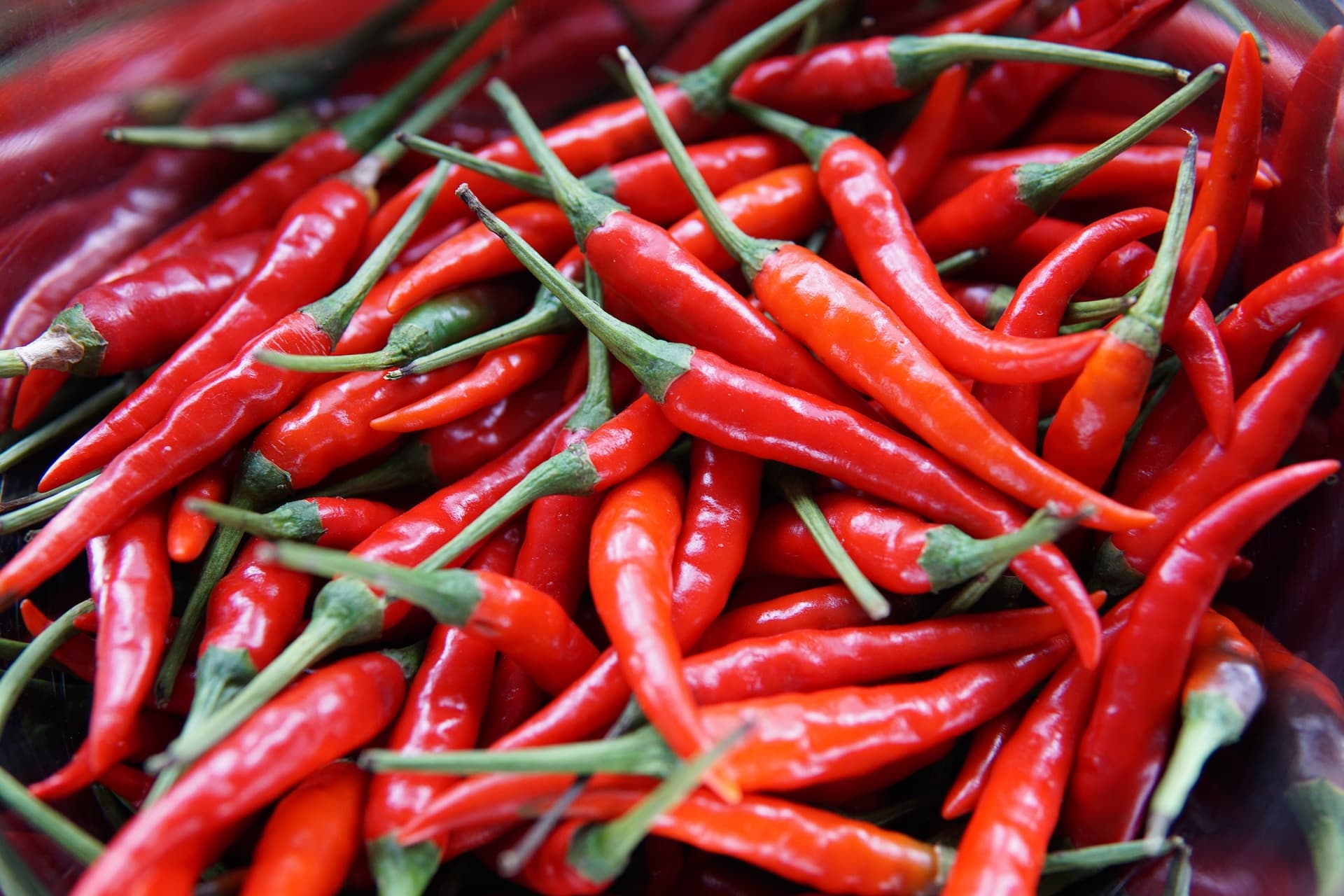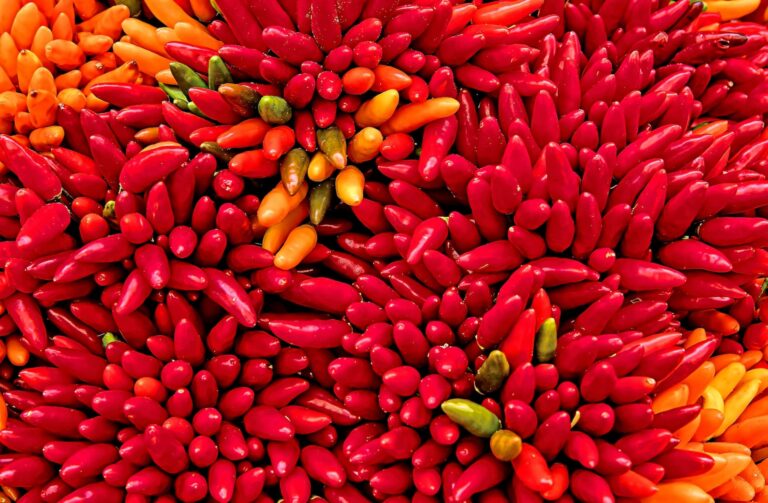When it comes to hot sauce, Thailand has many to choose from, with the most popular being Sriracha. The country has been able to tailor the original hot sauce recipe of chilis, salt and vinegar to suit their needs. In some cases, this has meant adding additional spices, or even giving their hot sauces a sweeter taste.
When you think of spicy foods, it’s common to instantly think of Asian cuisine, especially Thai. With so many of their dishes eaten worldwide, the popularity of Thai hot sauce will only keep increasing.
History of Asian Hot Sauce
Hot sauce first took Asia by storm in 1542. This was when the Portuguese brought chili peppers to Japan and then soon after to Korea [1]. They began to concoct their own hot sauce recipes, incorporating their spices into the hot sauce to add different flavors. After this, it wasn’t long until hot sauce soon came to the shores of Thailand.
A key turning point in Thai hot sauce history was the creation of Sriracha sauce. It was developed in the 1930s by a cook in her kitchen, Thanom Chakkapak [2]. Chakkapak used her sauce to serve over fish and after going down a treat with her family, they encouraged her to sell it commercially.
She decided to name the sauce after her hometown, Si Racha. It wasn’t long until the sauce became popular worldwide and now it’s available in nearly all grocery stores.
Another key figure of Asian hot sauce was David Tran. He worked at making the Sriracha sauce thicker and then sold this in bright red bottles. It’s commonly known for featuring the signature rooster printed on the front of the bottle. He started by selling this to local restaurants and customers. As popularity grew, he kept his prices low so that the sauce was readily available to anyone who wanted a taste.
Popular Types of Thai Hot Sauce
Nam Prik
Nam Prik has been created with Thai chilies, fish sauce, vinegar and garlic. Its name translates to “fluid chili”, which quite literally means chili sauce. Nam Prik sauce has a kick, without it making your mouth feel as though it’s on fire, making it perfect if you prefer flavor over heat [3].
Nam Prik sauce tastes great on shrimp fried rice, meats, tacos or even used as a marinade on meats such as chicken.
Sweet Chili Sauce
Sweet chili sauce can have less heat than other Thai hot sauces, however, it works well at adding a sweet flavor to foods. It’s commonly used to flavor fish, chicken dishes and spring rolls [4]. It can be used as a stir fry sauce or drizzled onto just about anything.
Chili sauce comes in different heat levels, you can purchase bottles of sauce that are packed with chili flakes or milder versions. If you’d rather tailor sweet chili sauce to your liking, you can buy a milder version and then add your own chili flakes.
Sriracha
As previously mentioned, the most popular sauce to come from Thailand is Sriracha. Blended with chili, garlic, salt and sugar, this hot sauce is commonly used as a dip or marinade to add a kick to your meat. Classic Thai dishes that the sauce is served with include Khai Jeow and the Thai Omelet [5].
The most popular Sriracha brands are Huy Fong and Flying Goose. They’re available in most grocery stores. Being so versatile, Sriracha can spice up just about any type of food in your kitchen.
Health Benefits and Nutritional Information
It may not be the first thing that springs to mind when you drizzle Thai hot sauce over your favorite Asian dish, but it has numerous health benefits. With the sauce created from chili peppers, you’ll find the hot sauce packed full of vitamin C to help with immunity. Chili peppers can even help to aid weight loss and reduce blood pressure.
Not only this, eating spicy Thai hot sauces can also help to aid weightless as the capsaicin found in chili peppers works at boosting your metabolism. If it’s eaten in small amounts, such as drizzle of hot sauce on some meat, then this can help your digestion, which also helps to burn more calories.
Other health benefits of Thai hot sauce include improving the health of your heart. Research has shown that capsaicin can prevent serious heart conditions and it’s also been known to lower cholesterol. It can also increase blood flow which can prevent heart attacks and strokes. [6].
Cooking with Thai Hot Sauce
Thai hot sauce is easy to incorporate into everyday meals and they don’t even have to be Thai! You can add sauces such as Sriracha to just about anything. It works well drizzled onto meats, eggs, rice and noodles.
You can also add hot sauce to just about any recipe to give your meal some spice. Some of the best dishes to add Thai hot sauce to include Spaghetti Bolognese, chilis and stews. Adding it to soy sauce also gives it a kick and you can even stir the sauce into honey to give both the soy and hot sauce a sweet twist.
If you feel like being creative, then you can even make your own Thai hot sauce. To create something like the Thai sweet chili sauce recipe all you’ll need is chili peppers, plenty of garlic, rice vinegar, salt, sugar, chili flakes, fish sauce and corn starch.
To start with you should add all the ingredients, except the corn starch, to a small pan. Heat the pan to boil, then reduce the heat so that it can simmer for five minutes. To thicken the mixture and make it more sauce like, add the corn starch to the pan and cook. Make sure you keep simmering the sauce until the corn starch has fully absorbed into the sauce. You can then pour it into a pot, allow to cool and then refrigerate [7].
With so many variations of Thai hot sauce, you’ll be sure to find one that you love. Whether you prefer a sweeter taste, a thicker sauce or something to drizzle over your chicken there’s a sauce for everyone. These sauces don’t just have to be used in Asian dishes. They can be used in any meal you please, even a Bolognese.
Not only are they diverse, but they also feature several health benefits such as providing your body with vitamins and preventing heart conditions. So, why not fire up your taste buds with a bottle of Sriracha or sweet chili sauce?
Sources
[1] Whalebone. “The History of Hot Sauce.” Whalebone.
[2] McNamee, G. L. “Sriracha.” Britannica.
[3] Fuego Box. “Nam Prik Hot Sauce.” Fuego Box.
[4] Thai Dragon. “Sizzling Products.” Thai Dragon.
[5] Thai Gold. “Sriracha.” Thai Gold.
[6] Thanyapura. “The Benefits of Chili Peppers.” Thanyapura.
[7] Hultquist, M. “Thai Sweet Chili Sauce Recipe.” Chili Pepper Madness, 2023.







